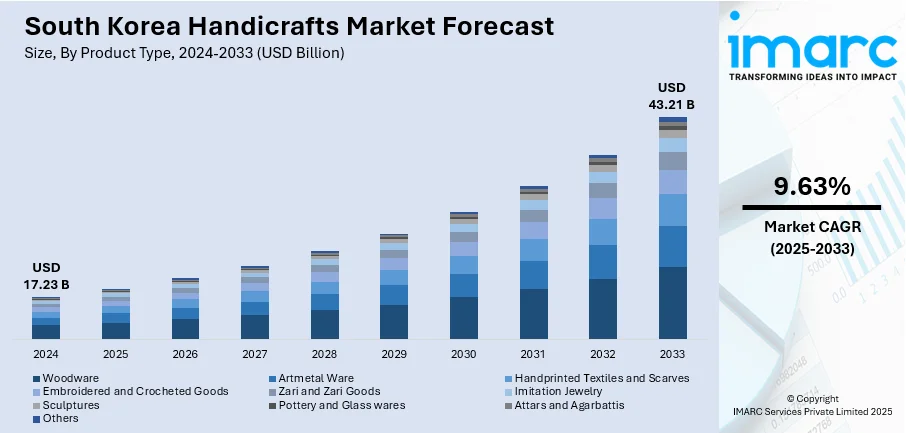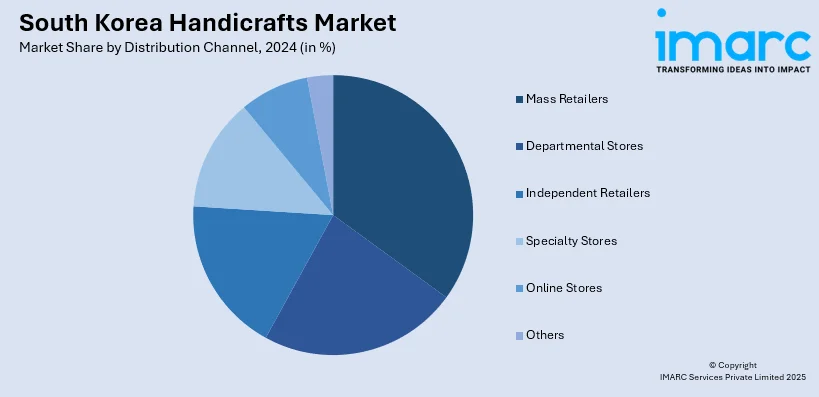
South Korea Handicrafts Market Size, Share, Trends and Forecast by Product Type, Distribution Channel, End Use, and Region, 2025-2033
South Korea Handicrafts Market Overview:
The South Korea handicrafts market size reached USD 17.23 Billion in 2024. Looking forward, the market is projected to reach USD 43.21 Billion by 2033, exhibiting a growth rate (CAGR) of 9.63% during 2025-2033. The market is fueled by a rich heritage of traditional crafts, along with rising interest in cultural exports. Government initiatives and global recognition of K-culture are boosting demand. South Korea handicrafts market share is growing through tourism, online platforms, and luxury collaborations.
|
Report Attribute
|
Key Statistics
|
|---|---|
|
Base Year
|
2024
|
|
Forecast Years
|
2025-2033
|
|
Historical Years
|
2019-2024
|
| Market Size in 2024 | USD 17.23 Billion |
| Market Forecast in 2033 | USD 43.21 Billion |
| Market Growth Rate 2025-2033 | 9.63% |
South Korea Handicrafts Market Trends:
Digital Transformation and E-Commerce
Online platforms and global marketplaces have transformed how Korean handicrafts are sold. Social media campaigns and influencer partnerships highlight cultural storytelling and the uniqueness of each handmade product, increasing visibility for local artisans. Virtual trade fairs and digital exhibitions enable buyers from around the world to explore Korean crafts, driving exports. The government’s push for digital transformation in the handicraft sector, including training in online marketing, is accelerating this growth. E-commerce has become a key channel for boosting sales and global recognition, making digitalization a cornerstone of South Korea handicrafts market growth. For instance, in September 2024, UNESCO ICHCAP and the Cheongju Cultural Industry Promotion Foundation launched the Residency Program for Kyrgyz Craftspeople 2024 in Korea. Supported by the Korea Heritage Service’s ODA project, the initiative aims to strengthen Kyrgyz artisans’ skills in craft production and digital marketing. The three-month program includes collaborations with Korean artists, seminars, and a final showcase at the Craft Trend Fair in December. The exchange fosters creative synergy and cultural tourism development between Korea and the Kyrgyz Republic.

To get more information on this market, Request Sample
Contemporary Adaptations of Traditional Crafts
Korean artisans are blending traditional craftsmanship with modern design elements to cater to changing consumer preferences. Products such as modern hanbok accessories, contemporary ceramics, and minimalist furniture inspired by Korean heritage are gaining attention globally. This approach appeals to consumers who value cultural authenticity and functionality. Collaborations with international designers have brought Korean handicrafts into luxury markets, further enhancing their global reach. This fusion of tradition and modernity is strengthening South Korea handicrafts market growth while ensuring the preservation of heritage techniques. For instance, in July 2025, Uzbekistan and South Korea strengthened cooperation in tourism and handicrafts through meetings and roundtable discussions between companies from Samarkand and Chungcheongbuk-do. Agreements were signed to launch joint handicraft production projects, aiming to enhance cultural ties and promote collaborative initiatives between the two regions.
South Korea Handicrafts Market Segmentation:
IMARC Group provides an analysis of the key trends in each segment of the market, along with forecasts at the region/country level for 2025-2033. Our report has categorized the market based on product type, distribution channel, and end use.
Product Type Insights:
- Woodware
- Artmetal Ware
- Handprinted Textiles and Scarves
- Embroidered and Crocheted Goods
- Zari and Zari Goods
- Imitation Jewelry
- Sculptures
- Pottery and Glass Wares
- Attars and Agarbattis
- Others
The report has provided a detailed breakup and analysis of the market based on the product type. This includes woodware, artmetal ware, handprinted textiles and scarves, embroidered and crocheted goods, zari and zari goods, imitation jewelry, sculptures, pottery and glass wares, attars and agarbattis, and others.
Distribution Channel Insights:

- Mass Retailers
- Departmental Stores
- Independent Retailers
- Specialty Stores
- Online Stores
- Others
A detailed breakup and analysis of the market based on the distribution channel have also been provided in the report. This includes mass retailers, departmental stores, independent retailers, specialty stores, online stores, and others.
End Use Insights:
- Residential
- Commercial
The report has provided a detailed breakup and analysis of the market based on the end use. This includes residential and commercial.
Regional Insights:
- Seoul Capital Area
- Yeongnam (Southeastern Region)
- Honam (Southwestern Region)
- Hoseo (Central Region)
- Others
The report has also provided a comprehensive analysis of all the major regional markets, which include Seoul Capital Area, Yeongnam (Southeastern Region), Honam (Southwestern Region), Hoseo (Central Region), and others.
Competitive Landscape:
The market research report has also provided a comprehensive analysis of the competitive landscape. Competitive analysis such as market structure, key player positioning, top winning strategies, competitive dashboard, and company evaluation quadrant has been covered in the report. Also, detailed profiles of all major companies have been provided.
South Korea Handicrafts Market Report Coverage:
| Report Features | Details |
|---|---|
| Base Year of the Analysis | 2024 |
| Historical Period | 2019-2024 |
| Forecast Period | 2025-2033 |
| Units | Billion USD |
| Scope of the Report |
Exploration of Historical Trends and Market Outlook, Industry Catalysts and Challenges, Segment-Wise Historical and Future Market Assessment:
|
| Product Types Covered | Woodware, Artmetal Ware, Handprinted Textiles and Scarves, Embroidered and Crocheted Goods, Zari and Zari Goods, Imitation Jewelry, Sculptures, Pottery and Glass Wares, Attars and Agarbattis, Others |
| Distribution Channels Covered | Mass Retailers, Departmental Stores, Independent Retailers, Specialty Stores, Online Stores, Others |
| End Uses Covered | Residential, Commercial |
| Regions Covered | Seoul Capital Area, Yeongnam (Southeastern Region), Honam (Southwestern Region), Hoseo (Central Region), Others |
| Customization Scope | 10% Free Customization |
| Post-Sale Analyst Support | 10-12 Weeks |
| Delivery Format | PDF and Excel through Email (We can also provide the editable version of the report in PPT/Word format on special request) |
Key Questions Answered in This Report:
- How has the South Korea handicrafts market performed so far and how will it perform in the coming years?
- What is the breakup of the South Korea handicrafts market on the basis of product type?
- What is the breakup of the South Korea handicrafts market on the basis of distribution channel?
- What is the breakup of the South Korea handicrafts market on the basis of end use?
- What is the breakup of the South Korea handicrafts market on the basis of region?
- What are the various stages in the value chain of the South Korea handicrafts market?
- What are the key driving factors and challenges in the South Korea handicrafts market?
- What is the structure of the South Korea handicrafts market and who are the key players?
- What is the degree of competition in the South Korea handicrafts market?
Key Benefits for Stakeholders:
- IMARC’s industry report offers a comprehensive quantitative analysis of various market segments, historical and current market trends, market forecasts, and dynamics of the South Korea handicrafts market from 2019-2033.
- The research report provides the latest information on the market drivers, challenges, and opportunities in the South Korea handicrafts market.
- Porter's five forces analysis assist stakeholders in assessing the impact of new entrants, competitive rivalry, supplier power, buyer power, and the threat of substitution. It helps stakeholders to analyze the level of competition within the South Korea handicrafts industry and its attractiveness.
- Competitive landscape allows stakeholders to understand their competitive environment and provides an insight into the current positions of key players in the market.
Need more help?
- Speak to our experienced analysts for insights on the current market scenarios.
- Include additional segments and countries to customize the report as per your requirement.
- Gain an unparalleled competitive advantage in your domain by understanding how to utilize the report and positively impacting your operations and revenue.
- For further assistance, please connect with our analysts.
 Request Customization
Request Customization
 Speak to an Analyst
Speak to an Analyst
 Request Brochure
Request Brochure
 Inquire Before Buying
Inquire Before Buying




.webp)




.webp)












